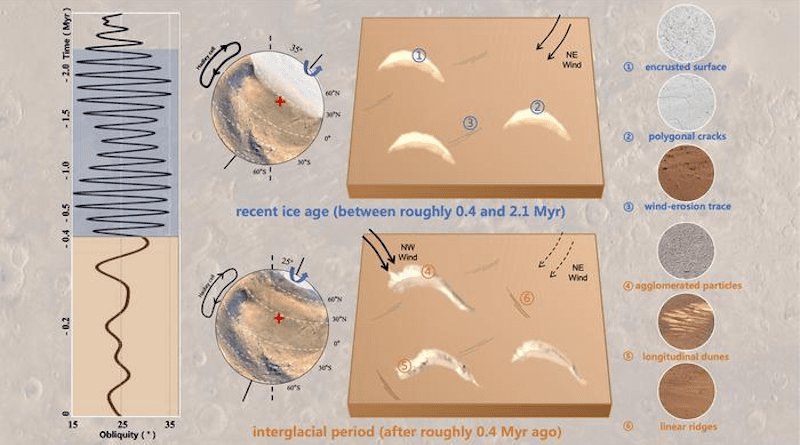Martian Dunes Eroded By Shift In Prevailing Winds After Planet’s Last Ice Age
Detailed analysis of data obtained by the Zhurong rover of dunes located on the southern Utopian Plain of Mars suggests the planet underwent a major shift in climate that accompanied changes in prevailing winds. This shift likely occurred about 400,000 years ago, which coincides with the end of the last glacial period on Mars.
Researchers from the National Astronomical Observatories, Institute of Geology and Geophysics and Institute of Tibetan Plateau Research of the Chinese Academy of Sciences, in collaboration with colleagues from Brown University, assessed the surface structure and chemical composition of Martian dunes to determine the age of sand structures and prevailing wind directions at different locations near the Zhurong rover landing site.
The team found that the prevailing wind direction on the southern Utopian Plain shifted nearly 70° from northeast to northwest, eroding crescent-shaped dunes formed during the last glacial period into dark, longitudinal ridges after the last Martian ice age.
The study was published in Nature.
“The exploration and research on the climate evolution of Mars has been of great concern for a long time. Mars is the most similar planet to Earth in the Solar System. Understanding Martian climate processes promises to uncover details of the evolution and history of Earth and other planets in our Solar System,” said Prof. LI Chunlai from the National Astronomical Observatories of the Chinese Academy of Sciences (NAOC), principal investigator of the study.
Prior research suggested that the Martian climate has changed over time, but the inability to directly measure and sample geological formations on Mars limited scientists’ ability to validate and better characterize the planet’s climate processes. LI’s team used high-resolution orbital cameras and the Zhurong rover’s terrain and multispectral cameras, surface composition analyzers and meteorological measuring instruments to finally obtain in situ data directly from the Martian surface.
The research team estimated that a change in the angle of the rotational axis of Mars caused the planet to exit its most recent ice age. The effects of this change were subsequently captured by the morphology, orientation, physical properties and stratigraphy, or layering, of dunes on the southern Utopian Plain of Mars, where the Zhurong rover landed.
The study was designed to integrate rover-scale data of dune formations and weather conditions to not only confirm a change in prevailing wind direction with the close of the last ice age, but also improve general circulation models used to predict finer-scale changes in seasonal wind direction. Importantly, prevailing wind data and dune stratigraphy at the rover landing area were consistent with the presence of ice and dust layers found at middle and higher latitudes of the planet.
A great deal of effort is being invested in characterizing the ancient climate of Mars over the course of the Amazonian epoch, which began between 3.55 and 1.8 billion years ago and continues to this day.
“Understanding the Amazonian climate is essential to explain the current Martian landscape, volatile matter reservoirs and atmospheric state, and to relate these current observations and active processes to models of the ancient climate of Mars. Observations of the current climate of Mars can help refine physical models of Martian climate and landscape evolution, and even form new paradigms,” said LI.
In situ studies on the Martian surface have enormous scientific value, and the Zhurong rover will be busy collecting data for some time. “We will continue to study both Amazonian and present-day climate to promote the knowledge regarding the last two billion years of Martian climate history, including its environment and processes,” said LI.

